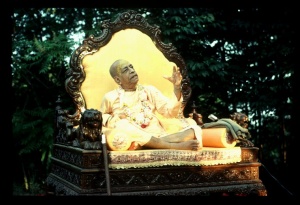SB 5.22.4: Difference between revisions
m (1 revision(s)) |
(Vanibot #0054 edit - transform synonyms into clickable links, which search similar occurrences) |
||
| (One intermediate revision by one other user not shown) | |||
| Line 1: | Line 1: | ||
{{info | {{info | ||
|speaker= | |speaker=Śukadeva Gosvāmī | ||
|listener=King | |listener=King Parīkṣit | ||
}} | }} | ||
[[Category:Srimad-Bhagavatam - Canto 05 Chapter 22|s04 ]] | |||
[[Category:Bhagavatam Verses Spoken by Sukadeva Gosvami - Vanisource|052204]] | |||
<div style="float:left">'''[[Srimad-Bhagavatam]] - [[SB 5|Fifth Canto]] - [[SB 5.22: The Orbits of the Planets|Chapter 22: The Orbits of the Planets]]'''</div> | |||
<div style="float:right">[[File:Go-previous.png|link=SB 5.22.3]] '''[[SB 5.22.3]] - [[SB 5.22.5]]''' [[File:Go-next.png|link=SB 5.22.5]]</div> | |||
{{RandomImage}} | |||
==== TEXT 4 ==== | ==== TEXT 4 ==== | ||
<div | <div class="verse"> | ||
tam etam iha puruṣās trayyā vidyayā varṇāśramācārānupathā uccāvacaiḥ karmabhir āmnātair yoga-vitānaiś ca śraddhayā yajanto 'ñjasā śreyaḥ samadhigacchanti | :tam etam iha puruṣās trayyā vidyayā varṇāśramācārānupathā | ||
:uccāvacaiḥ karmabhir āmnātair yoga-vitānaiś ca śraddhayā | |||
:yajanto 'ñjasā śreyaḥ samadhigacchanti | |||
</div> | </div> | ||
| Line 13: | Line 21: | ||
==== SYNONYMS ==== | ==== SYNONYMS ==== | ||
<div | <div class="synonyms"> | ||
''[//vanipedia.org/wiki/Special:VaniSearch?s=tam&tab=syno_o&ds=1 tam]'' — Him (the Supreme Personality of Godhead); ''[//vanipedia.org/wiki/Special:VaniSearch?s=etam&tab=syno_o&ds=1 etam]'' — this; ''[//vanipedia.org/wiki/Special:VaniSearch?s=iha&tab=syno_o&ds=1 iha]'' — in this world of mortality; ''[//vanipedia.org/wiki/Special:VaniSearch?s=puruṣāḥ&tab=syno_o&ds=1 puruṣāḥ]'' — all people; ''[//vanipedia.org/wiki/Special:VaniSearch?s=trayyā&tab=syno_o&ds=1 trayyā]'' — having three divisions; ''[//vanipedia.org/wiki/Special:VaniSearch?s=vidyayā&tab=syno_o&ds=1 vidyayā]'' — by the Vedic knowledge; ''[//vanipedia.org/wiki/Special:VaniSearch?s=varṇa&tab=syno_o&ds=1 varṇa]-[//vanipedia.org/wiki/Special:VaniSearch?s=āśrama&tab=syno_o&ds=1 āśrama]-[//vanipedia.org/wiki/Special:VaniSearch?s=ācāra&tab=syno_o&ds=1 ācāra]'' — the practices of the varṇāśrama system; ''[//vanipedia.org/wiki/Special:VaniSearch?s=anupathāḥ&tab=syno_o&ds=1 anupathāḥ]'' — following; ''[//vanipedia.org/wiki/Special:VaniSearch?s=ucca&tab=syno_o&ds=1 ucca]-[//vanipedia.org/wiki/Special:VaniSearch?s=avacaiḥ&tab=syno_o&ds=1 avacaiḥ]'' — higher or lower according to the different positions in the varṇāśrama-dharma (brāhmaṇa, kṣatriya, vaiśya and śūdra); ''[//vanipedia.org/wiki/Special:VaniSearch?s=karmabhiḥ&tab=syno_o&ds=1 karmabhiḥ]'' — by their respective activities; ''[//vanipedia.org/wiki/Special:VaniSearch?s=āmnātaiḥ&tab=syno_o&ds=1 āmnātaiḥ]'' — handed down; ''[//vanipedia.org/wiki/Special:VaniSearch?s=yoga&tab=syno_o&ds=1 yoga]-[//vanipedia.org/wiki/Special:VaniSearch?s=vitānaiḥ&tab=syno_o&ds=1 vitānaiḥ]'' — by meditation and other yogic processes; ''[//vanipedia.org/wiki/Special:VaniSearch?s=ca&tab=syno_o&ds=1 ca]'' — and; ''[//vanipedia.org/wiki/Special:VaniSearch?s=śraddhayā&tab=syno_o&ds=1 śraddhayā]'' — with great faith; ''[//vanipedia.org/wiki/Special:VaniSearch?s=yajantaḥ&tab=syno_o&ds=1 yajantaḥ]'' — worshiping; ''[//vanipedia.org/wiki/Special:VaniSearch?s=añjasā&tab=syno_o&ds=1 añjasā]'' — without difficulty; ''[//vanipedia.org/wiki/Special:VaniSearch?s=śreyaḥ&tab=syno_o&ds=1 śreyaḥ]'' — the ultimate benefit of life; ''[//vanipedia.org/wiki/Special:VaniSearch?s=samadhigacchanti&tab=syno_o&ds=1 samadhigacchanti]'' — they attain. | |||
</div> | </div> | ||
| Line 20: | Line 28: | ||
==== TRANSLATION ==== | ==== TRANSLATION ==== | ||
<div | <div class="translation"> | ||
According to the system of four varṇas and four āśramas, people generally worship the Supreme Personality of Godhead, Nārāyaṇa, who is situated as the sun-god. With great faith they worship the Supreme Personality as the Supersoul according to ritualistic ceremonies handed down in the three Vedas, such as agnihotra and similar higher and lower fruitive acts, and according to the process of mystic yoga. In this way they very easily attain the ultimate goal of life. | According to the system of four varṇas and four āśramas, people generally worship the Supreme Personality of Godhead, Nārāyaṇa, who is situated as the sun-god. With great faith they worship the Supreme Personality as the Supersoul according to ritualistic ceremonies handed down in the three Vedas, such as agnihotra and similar higher and lower fruitive acts, and according to the process of mystic yoga. In this way they very easily attain the ultimate goal of life. | ||
</div> | </div> | ||
__NOTOC__ | |||
<div style="float:right; clear:both;">[[File:Go-previous.png|link=SB 5.22.3]] '''[[SB 5.22.3]] - [[SB 5.22.5]]''' [[File:Go-next.png|link=SB 5.22.5]]</div> | |||
__NOTOC__ | |||
__NOEDITSECTION__ | |||
Latest revision as of 22:14, 18 February 2024

A.C. Bhaktivedanta Swami Prabhupada
TEXT 4
- tam etam iha puruṣās trayyā vidyayā varṇāśramācārānupathā
- uccāvacaiḥ karmabhir āmnātair yoga-vitānaiś ca śraddhayā
- yajanto 'ñjasā śreyaḥ samadhigacchanti
SYNONYMS
tam — Him (the Supreme Personality of Godhead); etam — this; iha — in this world of mortality; puruṣāḥ — all people; trayyā — having three divisions; vidyayā — by the Vedic knowledge; varṇa-āśrama-ācāra — the practices of the varṇāśrama system; anupathāḥ — following; ucca-avacaiḥ — higher or lower according to the different positions in the varṇāśrama-dharma (brāhmaṇa, kṣatriya, vaiśya and śūdra); karmabhiḥ — by their respective activities; āmnātaiḥ — handed down; yoga-vitānaiḥ — by meditation and other yogic processes; ca — and; śraddhayā — with great faith; yajantaḥ — worshiping; añjasā — without difficulty; śreyaḥ — the ultimate benefit of life; samadhigacchanti — they attain.
TRANSLATION
According to the system of four varṇas and four āśramas, people generally worship the Supreme Personality of Godhead, Nārāyaṇa, who is situated as the sun-god. With great faith they worship the Supreme Personality as the Supersoul according to ritualistic ceremonies handed down in the three Vedas, such as agnihotra and similar higher and lower fruitive acts, and according to the process of mystic yoga. In this way they very easily attain the ultimate goal of life.